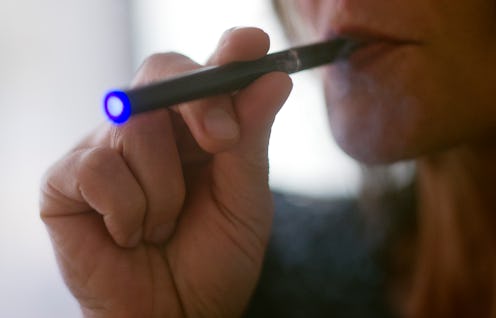In 2014, for the first time in years, the number of young Americans using tobacco products went up. However, the number of high school students using traditional cigarettes fell — all the way from 16 to 9 percent — along with cigars and pipes. Largely responsible for this trend is the rise of e-cigarettes, according to a new government report. Now, more high school students (13 percent total) smoke e-cigarettes than regular ones, and among high school and middle school students, the use of e-cigarettes tripled between 2013 and 2014 — a steady increase in growth rate after merely doubling between 2011 and 2012.
E-cigarettes have the nicotine that satisfies cravings for typical cigarettes, but they lack many of the side effects because they don't usually contain tobacco (though they can contain tobacco-derived nicotine, so the FDA recently proposed to classify them as tobacco products). Instead, inhaling e-cigarettes produces a vapor to mimic the experience of smoking. The liquid that serves as the basis for this vapor typically consists of nicotine, water, various chemicals, and sometimes a flavoring like "Sweet Tart" and "Unicorn Puke." I'd pass on the latter, but one student told The New York Times it was like “every flavor Skittle compressed into one” — so I guess we finally know what "tasting the rainbow" is really like. Or something.
The Times spoke with a number of teens who used e-cigarettes to quit smoking tobacco-based cigarettes. One 15-year-old even estimated that about 70 percent of his friends "vaped" — the slang term for using e-cigarettes.
E-cigarettes also appear to have taken on some of the social significance cigarettes have traditionally held, with one high school student saying he and his friends started at age 13 to do something "edgy and exciting." Alexander Wilson, who used e-cigarettes to quit smoking, has a less typical mental association with the device:
I was like, "Dude, why do you have a light saber?" ... And he was like, "No, that’s my e-cigarette."
E-cigarettes are still addictive and lead to withdrawal symptoms upon quitting, and the jury's still out on whether e-cigarettes carry any health risks. Some worry that the particles they introduce to your lungs could damage the respiratory system, which could be bad news for teens who start using them because their friends do or "it looks cool" or they like the taste. However, what's clear is that they're less risky than traditional cigarettes, and switching has significant health benefits. So, we can pretty safely consider it a positive that teens are choosing the lesser of two evils.
Images: Getty Images (2)
